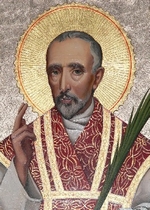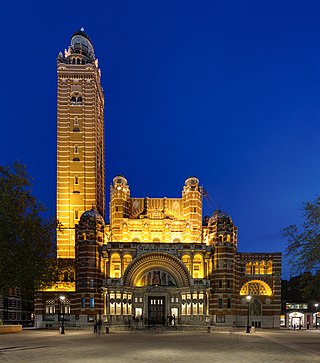Related Research Articles

Hugh Faringdon,, earlier known as Hugh Cook, later as Hugh Cook alias Faringdon and Hugh Cook of Faringdon, was an English Benedictine monk who presided as the last Abbot of Reading Abbey in the town of Reading in Berkshire, England. At the dissolution of the monasteries under King Henry VIII of England, Faringdon was accused of high treason and executed. He was declared a martyr and beatified by the Catholic Church in 1895.
Ralph Sherwin was an English Roman Catholic priest, executed in 1581. He is a Catholic martyr and saint.
William Knight was an English layman put to death for his Catholic faith at York, England. With him also suffered George Errington of Herst, Northumberland; William Gibson of Ripon; and Henry Abbot of Howden, Yorkshire.
William Gibson was a layman from Ripon in Yorkshire, England, a member of a noble Scottish family, who was executed at York for professing the Roman Catholic faith. He is honoured as a martyr by the Catholic Church.

The Forty Martyrs of England and Wales or Cuthbert Mayne and Thirty-Nine Companion Martyrs are a group of Catholic, lay and religious, men and women, executed between 1535 and 1679 for treason and related offences under various laws enacted by Parliament during the English Reformation. The individuals listed range from Carthusian monks who in 1535 declined to accept Henry VIII's Act of Supremacy, to seminary priests who were caught up in the alleged Popish Plot against Charles II in 1679. Many were sentenced to death at show trials, or with no trial at all.
George Nichols was an English Catholic martyr.

John Amias was a Roman Catholic priest who was martyred in England. He was beatified by Pope Pius XI in 1929.

John Payne (1532–1582) was an English Catholic priest and martyr, one of the Catholic Forty Martyrs of England and Wales.

John Southworth was an English Catholic martyr. He is one of the Forty Martyrs of England and Wales.

The Catholic Church in England and Wales is part of the worldwide Catholic Church in full communion with the Holy See. Its origins date from the 6th century, when Pope Gregory I through the Roman monk and Benedictine missionary, Augustine, later Augustine of Canterbury, intensified the evangelization of the Kingdom of Kent linking it to the Holy See in 597 AD.
Maurus Scott, born William Scott, was an English lawyer who became a Benedictine monk and priest, serving as a missionary in England during the period of recusancy. He was executed at Tyburn, and is a Catholic martyr.

Irish Catholic Martyrs were 24 Irish men and women who have been beatified or canonized for both a life of heroic virtue and for dying for their Catholic faith between the reign of King Henry VIII and Catholic Emancipation in 1829.

The Eighty-five Martyrs of England and Wales, also known as George Haydock and Eighty-four Companion Martyrs, are a group of men who were executed on charges of treason and related offences in the Kingdom of England between 1584 and 1679. Of the eighty-five, seventy-five were executed under the Jesuits, etc. Act 1584.
George Errington was an English Roman Catholic layman who is honoured as a martyr by the Catholic Church.
Charles Mahoney was an Irish Franciscan friar. He is consideres a martyr by the Roman Catholic Church, one of the Eighty-five martyrs of England and Wales beatified by Pope John Paul II in 1987. Their feast day is celebrated on 4 May.
William Harrington was an English Jesuit priest. He is a Roman Catholic martyr, beatified in 1929.

Edward Oldcorne alias Hall was an English Jesuit priest. He was known to people who knew of the Gunpowder Plot to destroy the Parliament of England and kill King James I; and although his involvement is unclear, he was caught up in the subsequent investigation. He is a Roman Catholic martyr and was beatified in 1929.

Dom Bede Camm, O.S.B., was an English Benedictine monk and martyrologist. He is best known for his many works on the English Catholic martyrs, which helped to keep their memories alive in the newly reemerging Catholic Church of Victorian England.
During the English Reformation, a number of believers were executed at Lancaster in England as a consequence of their Catholic faith. They are commonly referred to as the Lancaster Martyrs and are commemorated locally by the Lancaster Martyrs Memorial Stone which may be found close to the centre of Lancaster city.
References
- ↑ Watkins, Basil. The Book of Saints: A Comprehensive Biographical Dictionary, Bloomsbury Publishing, 2015, p. 305 ISBN 9780567664150
- ↑ Ryan, Patrick W.F. "Henry Abbot." The Catholic Encyclopedia. Vol. 1. New York: Robert Appleton Company, 1907. 27 January 2013
- ↑ Stanton, Richard. A Menology of England and Wales, Burns & Oates, 1887, p. 571